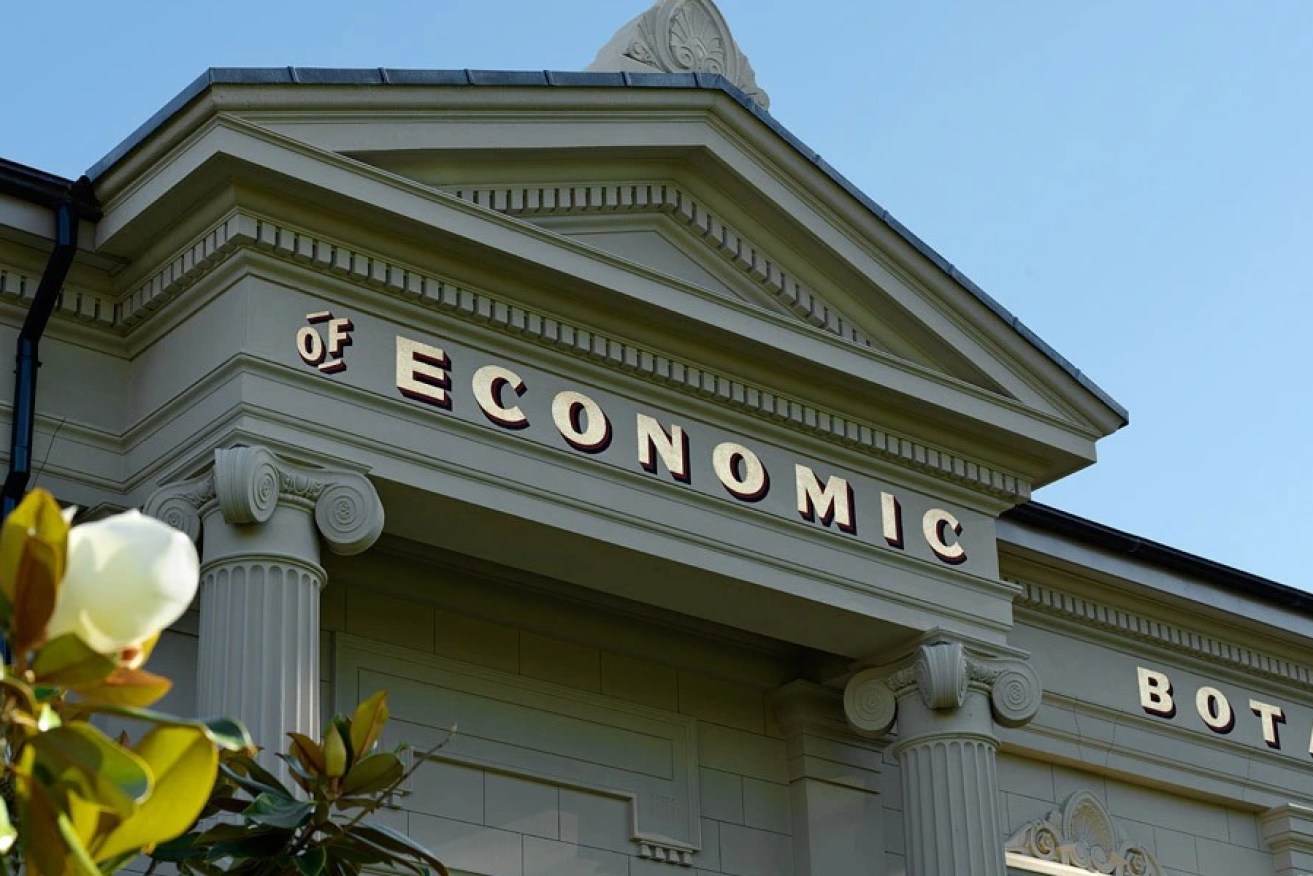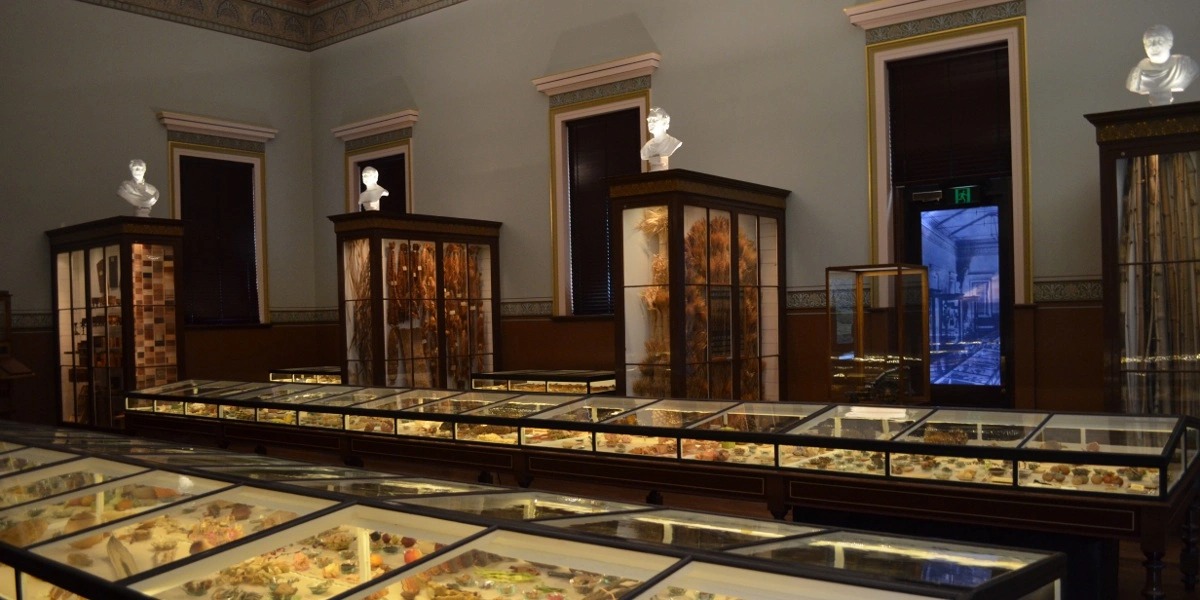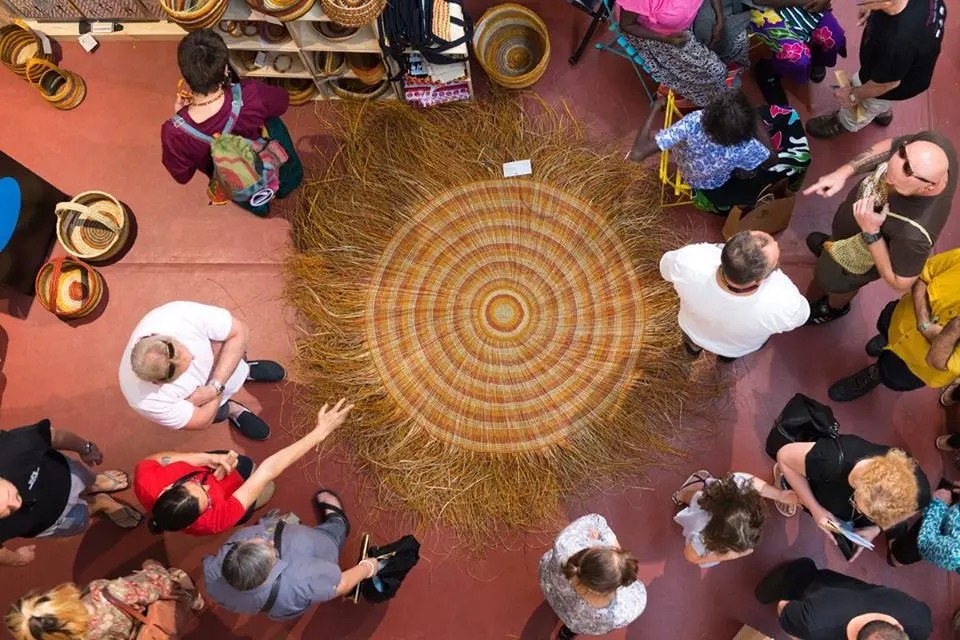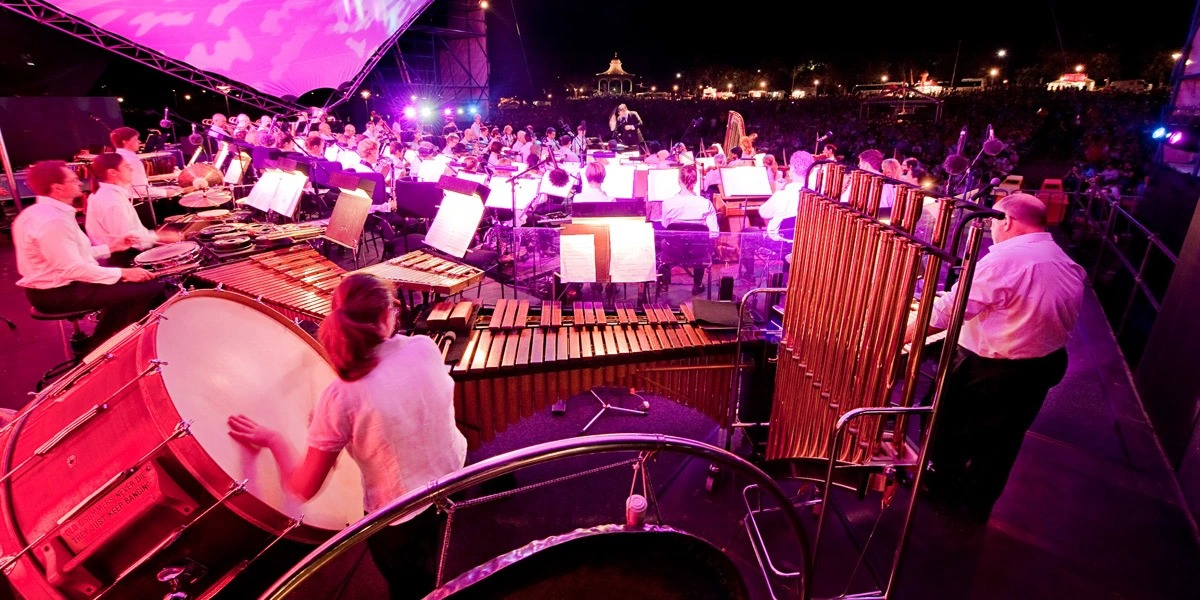The ‘artwashing’ debate arrives in Adelaide
Shifting community values and expectations are forcing South Australian cultural organisations to navigate a thorny path between corporate sponsorship, including from fossil fuel companies, and limited alternative funding options.


The Museum of Economic Botany is recognised as a unique and important public museum and gallery space. Photo: Grant Hancock
Earlier this month, oil and gas company Santos held its AGM.
From the event flowed a string of controversies. Amid revelations of a recent pipeline explosion and misuse of an Aboriginal elder’s image, there were also protests by Extinction Rebellion representatives and allegations that First Nations people asking questions about gas projects had their microphones cut.
The eventful AGM, conducted at the Adelaide Convention Centre, would seem to have little connection to the quiet, rolling grounds of the Adelaide Botanic Garden – apart, perhaps, from a common North Terrace location.
But an open letter to the Garden’s custodians from members of South Australia’s arts community argues otherwise.
Signed by more than 60 industry representatives and shared in mid-January, the letter states that Santos’s naming rights sponsorship of the Garden’s Museum of Economic Botany – which incorporates a visual art gallery – helps grant the company a “social licence” for its work and actions.
The letter says that in the current climate emergency, Santos’s recent status (as reported in 2020-21) as one of Australia’s 10 highest greenhouse gas emitters makes the association particularly untenable.
Rachel Healy, an arts industry consultant, former co-director of the Adelaide Festival and signatory to the letter, says organisations like the Botanic Garden have a responsibility to be cultural leaders.
“[An organisation’s importance] is not only measured in terms of its economic value to the state,” she says, “but in terms of their social value, their cultural value, their contribution to health outcomes, their contribution to civic amenity, and fostering community connections.
“When there’s an absence of an appropriate values framework and the policies that might flow from that, it would seem to me to be a kind of derogation of your duties.”
Another signatory to the letter, Mirning artist and academic Ali Gumilya Baker, says she was motivated to sign because of the imbalance she sees between corporate profits and community contributions.
“I am really concerned about companies that are making huge amounts of profits and then putting such a minute amount into communities. Particularly if those profits are made from Aboriginal land – the settler-Colonial processes have not benefited Aboriginal people in this country, so there’s layers of that, and then there’s only a minute amount of money put back into community and cultural renewal.”
The Santos Museum of Economic Botany is far from an isolated example of what is often referred to as “artwashing”.
In 2019, artists Gabrielle de Vietri and Will Foster – working under the name A Centre For Everything – created an exhaustive map that tracks the links between Australian arts organisations and the fossil fuel industry.
The tangled and intricate web reveals a dizzying interconnectedness. Many organisations contend these are practical decisions, with corporate relationships provisioning funds for important and purposeful programs.
Asked to respond to the open letter about the Museum of Economic Botany, the Botanic Garden and State Herbarium director Michael Harvey provided a statement that underlined the sustainability work the partnership had enabled.
“As is the case for many cultural institutions, sponsorship supports several of the horticultural, science, conservation and educational programs and activities we provide,” Harvey says.
“Our institution recognises the financial support that Santos provided between 2009 and 2017 to restore the Museum of Economic Botany and to support the work of both the SA Seed Conservation Centre, and some of our education programs. These activities have all had a positive impact for our South Australian community, and for the sustainability of the environment more broadly.”
Harvey did not respond directly to questions about the open letter’s call to revoke Santos’s naming rights of the museum, nor did Santos respond to a request for comment.

Art exhibitions are presented in the Museum of Economic Botany. Photo: Bension Siebert
The other most visible partnership between an extractive industries company and a cultural organisation in SA is the relationship between the Art Gallery of South Australia’s Tarnanthi and principal partner BHP. The corporation has provided significant financial support to the festival of Aboriginal and Torres Strait Islander art since its inception in 2015.
Tarnanthi artistic director Nici Cumpston, who is of Afghan, English, Irish and Barkindji heritage, says the BHP sponsorship has facilitated far-reaching and deep changes in the South Australian arts landscape. Beyond statistics like 1.6 million attendees and more than 6000 artists exhibited at Tarnanthi, and more than $6.6 million worth of art sales made at the Tarnanthi Art Fair, she says there have been cultural shifts that would be unlikely to flow from smaller-scale investment.
Cumpston cites long-term education programs, changes at AGSA itself – including increasing numbers of First Nations staff and new approaches to programming – and impacts in the wider arts community as examples.
“That was another really big component of our ideas at the beginning – how else can we make change?” she says.
“[We are going] out and meeting with all of the other arts organisations across the city and the state and inviting them to be part of Tarnanthi. At the beginning, it was really hand-holding. People didn’t know who to approach, they didn’t have relationships with Aboriginal people, and so it’s been a way of us being able to support them to learn and to understand and to now form their own partnerships.
“To enable more people [to work] and other ways of working and presenting work – that was really important to BHP because what that means is stronger community.”

Tarnanthi Art Fair has facilitated more than $6.6 million worth of art sales, with proceeds going direct to artists and art centres. Photo: John Montesi
AGSA’s head of philanthropy and corporate support, Vincent Ciccarello, says ethical considerations and community values are important elements when assessing partnerships, but these issues are more complex than ruling out an industry such as fossil fuels entirely.
“They [BHP] as a company have made significant changes within their own operations,” he says. “Divesting their coal interests, primarily. They are a resources industry rather than a fossil fuel industry… so there are distinctions to be made.
“We have open conversations about this with our colleagues at BHP and they are accountable; they talk about changing their business model to a greener energy future so that the resources they deliver – in the case of potash, for example, and copper – these things are necessary for a green Industry future.”
BHP recently merged its oil and gas portfolio with Woodside, and maintains some active coal interests.
Both the Adelaide Festival and the Adelaide Symphony Orchestra have previously had partnerships with Santos. The Festival’s relationship with Santos ended in 2015, while the company had naming rights of the ASO’s Symphony Under the Stars event from 1999 until early 2014.
Colin Cornish, who became chief executive of the ASO in October last year, says the organisation currently assesses its partnerships and potential partnerships on a case-by-case basis.
“We recognise that in a partnership, each entity will be seen to reflect the values of the other to a greater or lesser extent,” he says.
“We are looking for partners that will add value to the ambitions of the ASO, and we would expect that our partners seek to achieve the same through appropriate mutual benefit. The alignment of the brand and community values of both partners is therefore a key consideration.”

Santos was naming-rights sponsor of the ASO’s Symphony Under the Stars until 2014. Photo supplied
Community values is a complicated metric for arts organisations to navigate, particularly as they are ever-evolving. In the ’70s, many cultural organisations were supported by the tobacco industry via sponsorships that would be unthinkable today.
The existential threat of the climate crisis has pressed fossil fuel companies into the spotlight, but they are not the only industry under scrutiny. Arts institutions around the world have been pushed to sever ties with the Sackler family, whose company produces Oxycontin – a key drug implicated in the opioid crisis.
In 2022, the Sydney Festival came under fire for accepting support from the Israeli Embassy, while the tables were turned during the Adelaide Festival’s 2023 Writers’ Week, when some sponsors withdrew due to controversy over comments made by Palestinian speakers included the program.
For Tarnanthi, AGSA uses what Cumpston and Ciccarello call a “continuous consent” model to monitor community support – speaking upfront with all exhibiting artists about the BHP funding.
Julian Hobba, executive director of the State Theatre Company of South Australia, says his organisation navigates the shifting sands of community expectations by tuning in to the tenor of social conversations.
“We think that means we have to be very wary of entering into partnerships that would undermine our ability to make people think critically about the most pressing social conversations that we’re engaged in, which includes environmental issues and climate change, reconciliation, diversity of representation and many other things,” he says.
We do need to have a broader conversation about how we support and invest in the creative industries
Rachel Healy says it is the role of an organisation’s board to create frameworks that help draw the line between what is acceptable and what isn’t.
“I think that it kind of goes back to the first principles of governance,” she says. “It is the responsibility of cultural boards and committees to establish a policy on sponsorship… the worst time to do it is on the fly.
“Surely that’s the core business of a board – to calmly consider all the implications of your sponsorships and donations policies, set it out in a draft policy framework and then socialise it with stakeholders, community and government, so when these things come up, they don’t just sort of land like a hand grenade.”
Healy also points out that what she calls “boards of tension” – those which contain diverse people and viewpoints representative of the wider community, rather than those that are homogenous – are better equipped to judge a potential sponsorship’s acceptability.
Another complicating factor for organisations, artists and communities navigating the ethics of financial support is transparency and visibility.
Mirning artist and academic Baker says her discomfort around sponsorship relates mainly to the opaque processes through which money is allocated and what is expected in return.
“From my perspective, there’s really big concerns, especially in relation to Aboriginal communities and the way these companies are engaging with Aboriginal communities. Communities are often not privy to the deals that have been done with other communities or other organisations…”
Healy, Hobba and Cumpston all agree that there are different and more rigorous considerations required for deals that involve significant branding opportunities, such as naming rights, as opposed to those that are anonymous or less visible.
Despite the many complexities of engaging with corporate sponsors, many organisations believe they have little choice.
“We do need to have a broader conversation about how we support and invest in the creative industries to allow us to develop our own income streams,” Hobba says.
“There are so many opportunities everywhere for art and culture to be a major economic driver and support a smart state strategy in South Australia, but you need the investment to be sustained and predictable to underpin the development.”
Cumpston says that corporate money is currently filling gaps left by public spending.
“Ideally, the State Government would be supplying and supporting all of the needs of the arts organisations across the state and federal governments [should be] supporting in that way, too. That would be ideal, [but] that’s not our reality,” she says.
But the sector is not unanimous. Healy says her tenure at Adelaide Festival was led by a big vision with growth supported by corporate and philanthropic partners that “did not compromise our core values”.
Documentarian Alex Kelly – speaking on an Adelaide Festival panel in 2022 – points to the feeling that these partnerships are inevitable as one of their most dangerous traits.
We start to think, ‘If we do x, how will that damage our relationship with this funder?’
“We accept the absence of the state and we accept that these corporations are going to pick up the tab,” Kelly says.
“When we do that, we also step into a relationship that has very insidious and slippery implications for our creativity. And these things are really hard to pin down, because we sign contracts when we get funding that says they’re not going to buy editorial control, but even having these kinds of conversations makes programmers nervous, makes festivals nervous, because we start to self-censor.
“We start to think, ‘If we do x, how will that damage our relationship with this funder?’.”
It is a weighty and complex issue for arts organisations to grapple with, particularly as they try to juggle often conflicting priorities – finding the funds to deliver important programs, while also meeting the community’s moral expectations.
Baker says it is not a problem arts organisations and artists should tackle alone. Creating new structures to meet new ethical expectations, she says, is a responsibility for us all.
“I have an enormous amount of faith in small communities having huge power to change things,” she says. “So, I really encourage everyone that I work with and teach to use their voice to speak about things that are important and the kinds of societies that we want to live in, because everyone has agency in that way.”




